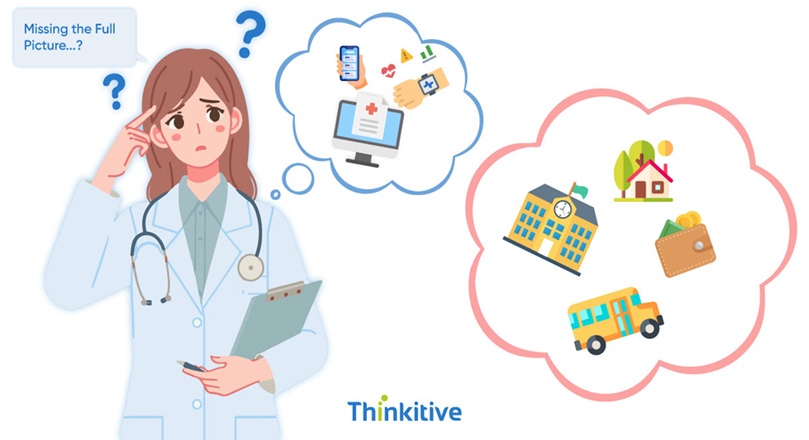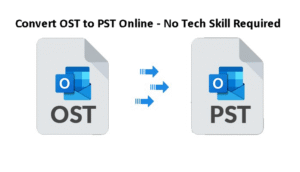
Are you aware of how a patient’s living condition and daily life can affect their overall health outcomes? A recent study suggests that physician care contributes only 20% of outcomes while SDOH (Social Determinants of Health Data), such as environment, lifestyle, and more, account for almost 80%.
This is a shocking fact, and most hospitals do not collect this data through EHRs or do not collect it at all. Providers need to understand factors like housing, income, family situation, food security, and more to provide better treatment.
So, if it is included in health records, it can change the outcomes dramatically. It can increase the scope and quality of care and provide a holistic view of patients’ conditions.
Here, leveraging healthcare interoperability solutions can help hospitals effectively record these SDOH directly into their EHRs. Not only that, if seamless EHR integration is achieved, providers will be able to continuously monitor changes in patients’ lifestyles, preventing any deviation in care plans.
It can completely change how providers look at social determinants from just an afterthought to a crucial way to improve patient outcomes. But achieving this is not an overnight thing. A deep understanding of how SDOH affects patient care is needed, along with the right approach to seamlessly integrate this data into EHR systems.
This blog will dive into these details and help you understand how understanding the social life of patients can be the key to improving the final outcomes.
Understanding Social Determinants of Health: The Missing Piece in Clinical Care
Patient treatments do not depend only on lab tests, consultations, and medications. There is one more factor that impacts the entire care journey of every patient: social determinants of health (SDOH).
Social Determinants of Health refer to the non-medical factors that influence health outcomes, such as income level, educational background, and even living environments. And these are not just questions for the “get to know your patients” category. They are crucial pieces that can influence care plans and treatments.
If a patient’s income is low or they do not have fixed housing, then expecting them to follow through with the care plan is not correct. Economic stability, like employment status, debt, out-of-pocket medical costs, and educational level, shapes how patients will receive the treatment.
Yet, the traditional EHRs rarely capture these risk factors. Providers are left guessing why treatments fail, unaware of the barriers patients face outside the clinic. This incomplete view limits care quality and leads to missed opportunities for early intervention.
And now that healthcare is shifting towards value-based care models, integrating SDOH into health records is essential for providing holistic care. This gives better risk stratification, more targeted population health efforts, and stronger performance on quality metrics, all coming from having the whole picture.
Data Sources & Collection Strategies for Social Determinants Integration
Asking questions of the patients is not the only source of collecting SDOH. You can collect this information from patient-reported data, public databases, and cross-sector integration, with the help of EHR data integration and various tools. Let’s take a look at how:
• Patient-Reported Screening Tools: Standardized tools like PREPARE and the AHC HRSN screening tool are becoming essential for capturing patient-reported SDOH data. When these tools are integrated into digital intake forms or patient portals, they allow for efficient, structured data capture without burdening providers. Mobile-friendly versions also ensure broader reach across diverse populations.
• Community & Public Data: Only having individual data is also not enough. Collecting data about the community of patients is also necessary. Here, the American Community Survey and local public health departments provide environmental and socioeconomic context. Knowing their patient housing, food conditions, and air quality can be layered in the patient profile, helping identify at-risk populations based on where they live.
• Healthcare Interoperability Across Systems: Modern Health Information Exchange (HIE), CBO partnerships, and cross-sector data-sharing platforms allow clinical teams to access non-clinical data sources. This means you can integrate information from schools, housing agencies, or social services to bridge the gap between healthcare and real-world needs.
• Real-Time Monitoring: With consent and strict privacy protocols, technologies like wearables, geospatial tools, and even social media listening can offer dynamic insights into lifestyle, behavior, and environmental exposures. This shift from static to real-time data opens doors to proactive, personalized interventions.
Technical Architecture for Social Determinants EHR Data Integration
When it comes to connecting social determinants of health to the EHR systems, you need a robust technical support that keeps data exchange seamless. Moreover, it needs to be secure and able to protect patient privacy without compromising efficiency.
To build a sustainable architecture, healthcare organizations must align with existing standards like FHIR, Z-codes, and SNOMED. Meanwhile, it also needs to prepare the systems to handle sensitive data ethically and securely.
Here’s how the different components fit together:
| Component | Description |
| Data Standardization | Uses ICD-10 Z-codes, FHIR SDOH profiles, SNOMED CT, and LOINC to document and exchange consistent SDOH information across systems. |
| EHR Workflow Integration | Adds custom fields/templates for SDOH, integrates decision support tools, and links with population health modules for actionable use in care delivery. |
| Privacy & Consent Management | Implements role-based access, patient consent controls, and elevated privacy protections for sensitive SDOH data like housing or immigration status. |
| Analytics Infrastructure | Combines clinical and social data in data warehouses, supports predictive modeling, and uses dashboards for population-level SDOH insights. |
This kind of architecture ensures that SDOH data becomes a living part of clinical care and helps personalize care and proactively treat patients at both the individual and community levels.
Clinical Applications & Use Cases for Integrated Social Determinants Data
After you successfully complete the EHR data integration, it becomes more than just additional data in the patient profile. It drives smarter, more personalized clinical decisions and improves the accuracy of the treatment. From identifying at-risk patients to connecting them with community resources, integrated SDOH transforms the care journey. Let’s see some clinical applications:
• Smarter Risk Stratification & Proactive Care
If you include social risk factors like housing insecurity or transportation issues in patient scoring models, providers can better identify who needs proactive outreach. This allows care teams to prioritize patients who might otherwise fall through the cracks, like enrolling those with both diabetes and unstable housing into care management programs.
• Customized Treatment & Intervention Planning
Not all patients can afford the medication and other treatment plans. With SDOH insight embedded in the EHR, providers can tailor treatment plans, choosing lower-cost medications, scheduling telehealth instead of in-person visits, or involving a care navigator to address support needs during discharge planning.
• Strengthening Care Coordination & Resource Referrals
With automated referrals and shared visibility, care teams can seamlessly connect patients with food banks, housing support, or financial counseling. Social workers, community health workers, and physicians can finally operate from the same playbook, with follow-ups tracked within the EHR.
• Powering Populations Health & Health Equity
At the macro level, this data fuels smarter public health strategies. Whether it’s identifying a spike in asthma linked to poor housing or tailoring outreach for a specific ZIP code, integrated SDOH supports targeted interventions. It also helps close health equity gaps with data-driven precision.
Implementation Strategies & Change Management for Social Determinants Integration
Integrating social determinants of health (SDOH) into EHRs is not just a tech project; it’s a change in how all healthcare operations function. It impacts how providers assess patients, how staff engage with care planning, and how communities partner with clinics.
That’s why successful implementation requires more than just the right software, and it needs careful planning, phased execution, and deep change management. Here’s how healthcare organizations can approach the integration journey:
| Strategy Area | Key Actions |
| Organizational Readiness | Identify SDOH champions, engage clinical leadership, train staff, and prepare workflows for social risk screening and documentation. |
| Phased Implementation | Start with a pilot (e.g., chronic care patients), expand gradually, and iterate based on feedback from clinical teams and measurable outcomes. |
| Technology & Vendor Strategy | Work with EHR vendors to enable SDOH fields and tools; consider third-party platforms or APIs for specialized data capture and community connections. |
| Partnership Building | Collaborate with local CBOs, social service agencies, and public health departments to extend support beyond the clinic. |
| Quality Improvement | Track KPIs, monitor patient outcomes, and measure ROI through reduced ED visits, readmissions, and improved equity metrics. |
Conclusion
Integrating social determinants of health data with EHR systems represents healthcare’s evolution from treating symptoms to addressing root causes of health disparities. This integration transforms healthcare delivery from reactive sick care to proactive health promotion that acknowledges the complete context of patients’ lives and circumstances.
So, now it is no longer just private information and has become a crucial part of creating an effective and personalized care plan for patients.
Want to integrate social determinants of health and transform your patient outcomes completely? Contact us to start integration and get a complete 360-degree view of the patient’s condition.
Also Read: The Essential Role of Hospitality ERP Software in Streamlining Operations
Frequently Asked Questions
1. What are the most effective social determinants screening tools for integration with EHR systems?
The most effective tools for screening social determinants of health are PRAPARE, AHC-HRSN, and WE CARE. These are widely adopted due to their structured formats and compatibility with EHR systems. They capture key SDOH domains and can be customized for integration via FHIR or HL7 interfaces.
2. How do healthcare organizations ensure patient privacy when collecting sensitive social determinants data?
They use encryption, role-based access controls, and obtain explicit patient consent. Training staff to handle sensitive conversations respectfully and storing SDOH data in secure, HIPAA-compliant systems is also critical for privacy protection.
3. What are the technical requirements for integrating social determinants data with existing EHR systems?
Key requirements include FHIR or HL7 support, structured data fields for SDOH, API compatibility, and the mapping of social needs codes like Z-codes to clinical workflows without breaking interoperability.
4. How can healthcare organizations measure ROI from social determinants interventions and data integration?
They track reductions in ED visits, hospital readmissions, and non-medical care costs. ROI can also be measured through improved patient engagement, better care coordination, and success in meeting value-based care incentives.
5. What community partnerships are essential for successful social determinants integration?
Collaborations with food banks, housing services, transportation providers, employment agencies, and legal aid organizations are vital. These partners extend care beyond the clinic and act on referrals generated through EHR-integrated tools.
6. How do social determinants integration efforts support value-based care and quality reporting?
By addressing root causes of poor health, SDOH integration improves outcomes and lowers costs—key goals in value-based care. It also supports reporting for programs like MIPS and ACO quality measures using coded SDOH data.
7. What are the biggest implementation challenges for social determinants EHR integration?
Major challenges include a lack of standardized data formats, limited staff training, workflow disruption, and inconsistent community resources. Smaller clinics especially struggle with funding and tech infrastructure needed for full integration.
8. How can smaller healthcare organizations afford comprehensive social determinants integration?
They can start with grant funding, partner with local nonprofits, and use modular EHR tools that support SDOH without a full platform overhaul. Participating in ACOs or Medicaid initiatives also provides financial support.
9. What role do community health workers play in social determinants data collection and intervention?
CHWs act as frontline connectors, screening patients, building trust, collecting accurate SDOH data, and coordinating services. Their community knowledge makes them essential for both data accuracy and effective social interventions.
10. How does social determinants integration support health equity and population health goals?
It helps identify and close care gaps caused by non-medical factors like poverty, housing, and food insecurity. Integrating this data into care plans promotes more equitable, whole-person care across entire populations.
11. What are the regulatory considerations for social determinants data collection and sharing?
SDOH data must be collected under HIPAA compliance, with informed consent. Sharing across organizations requires data use agreements, and in some states, there are specific privacy laws around housing, immigration, or financial status.
12. How can healthcare organizations train staff to effectively use integrated social determinants data?
They should combine EHR-specific training with cultural competency education, role-playing scenarios, and hands-on practice in screening workflows. Training should emphasize empathy, documentation accuracy, and using data to guide care coordination.







